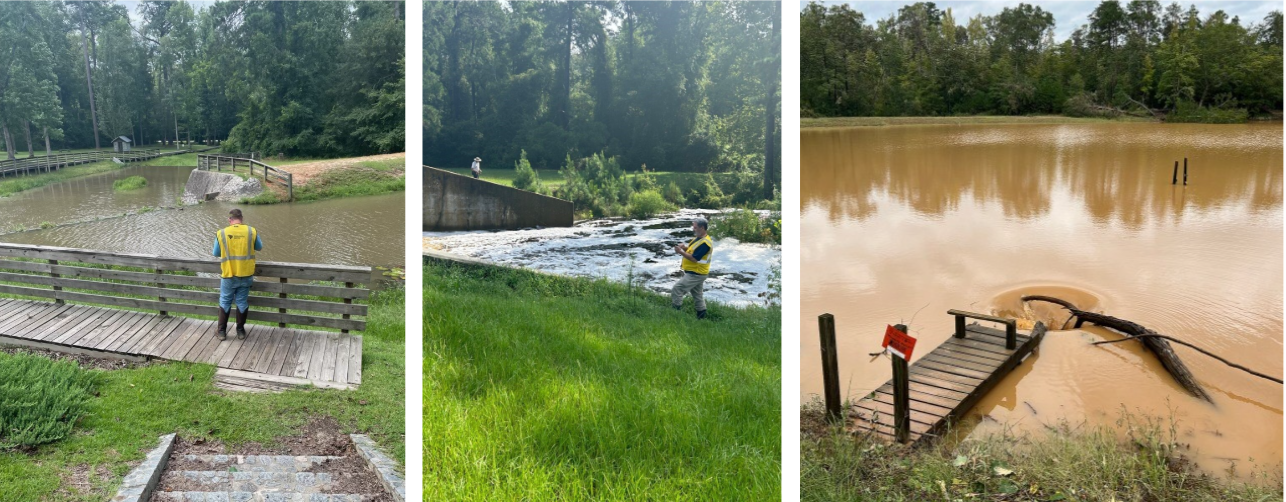S.C. Department of Environmental Services (SCDES) Promotes Dam and Reservoir Education and Awareness for National Dam Safety Awareness Day
FOR IMMEDIATE RELEASE:
May 27, 2025
COLUMBIA, S.C. ― During Dam Safety Awareness Day on May 31, the S.C. Department of Environmental Services (SCDES) encourages residents to learn how dams function and are regulated and to be mindful of important tips for those who live or work near water bodies created by dams.
Dams are an important part of national, state and local infrastructure. Nearly all freshwater lakes and ponds in South Carolina are created by a dam built across a river or stream. Dams impound water for a variety of reasons, such as irrigation, hydroelectricity, recreation, flood control, water supply, and for fish and wildlife.
SCDES’s Dams & Reservoirs Safety Program plays a critical role in ensuring dam owners keep their structures safe, strong and secure. In South Carolina, almost 2,200 dams are subject to state regulation. An interactive map of every regulated dam in the state is available via des.sc.gov/dams.

SCDES Dam Safety Inspectors perform routine inspections of regulated dams throughout the state. Prior to forecasted heavy rainfall events, inspectors also proactively conduct pre-storm assessments to help make sure dam owners have made storm preparations to their dams, including keeping spillways free of debris.
“The South Carolina Dams and Reservoirs Safety Act, which is the primary law concerning dams, states that a dam owner is solely responsible for maintaining their dam in a safe condition through the life of the structure,” said John McCain, Manager of SCDES’s Dam Safety Section. “One of the main roles of our Dam Safety Program is to make sure dam owners understand this responsibility. Our inspectors work closely with dam owners to explain any issues that need to be addressed to ensure their dams meet applicable safety standards.”
In South Carolina, a dam is regulated by the state if it:
- Is 25 feet or greater in height from top to bottom of the structure
- Can impound 50 acre-feet (equivalent to 16.3 million gallons) or more of water at maximum storage
- Represents a high-hazard potential where improper operation or dam failure may cause loss of human life, regardless of the overall size of the dam
Regulated dams are then categorized by hazard potential:
- High Hazard (C1): a structure where failure will likely cause loss of life and/or serious damage to infrastructure
- Significant Hazard (C2): a structure where failure will not likely cause loss of life infrastructure may be damaged.
- Low Hazard (C3): a structure where failure may cause limited property damage.
Every regulated dam classified as High or Significant Hazard is required to have an Emergency Action Plan, which is a written document that outlines the actions dam owners should take when a dam is at risk of failure. It identifies the areas that could be impacted if the dam fails and includes specific actions to be followed to minimize injury or loss of life and property damage if the dam is near failure or has failed.
The Association of State Dam Safety Officials provides an online Dams 101 resource where dam owners and people who live or work near dams and reservoirs can find in-depth information, graphics and resources that explain the importance of dams, as well as potential risks associated with them.
Nationally, the U.S. Army Corps of Engineers maintains a National Inventory of Dams for the more than 90,000 regulated dams across the country, of which 18% are considered High Hazard dams.
National Dam Safety Awareness Day is recognized every May 31 to commemorate the failure of the South Fork Dam in Johnstown, PA, on May 31, 1889. The Johnstown disaster was the worst dam failure in the history of the United States, with over 2,200 lives lost. National Dam Safety Awareness Day was created to encourage and promote individual and community responsibility and best practices for dam safety.
Learn more about South Carolina’s Dams and Reservoirs Safety Program at des.sc.gov/dams.
###

